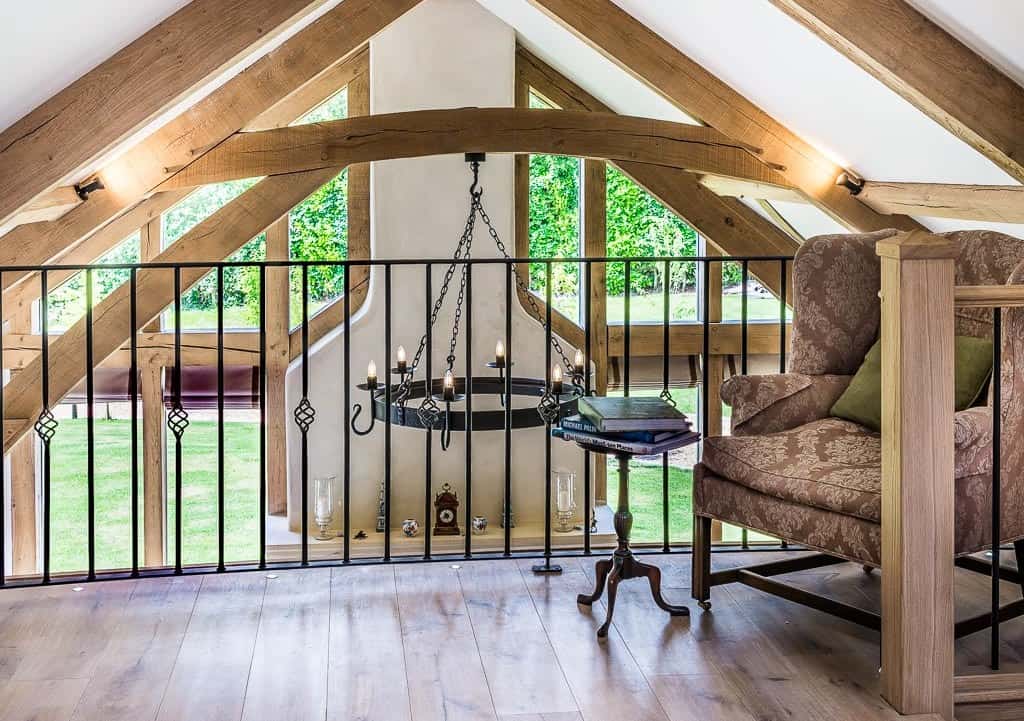Oak framing or timber frame? It doesn’t have to be either or!

Timber frame homes often conjure images of large exposed beams, posts and trusses formed in Oak. If you’ve set your heart on an oak frame, it’s not hard to understand why! Oak frame buildings have been constructed for centuries due to the strength, durability and beauty of this majestic hardwood.
There are three main ways you can incorporate oak into your new build dwelling; construct a full oak frame, utilise a part oak frame or incorporate decorative oak features.
A full oak frame is where the primary structural shell of the building is created entirely in oak. The ‘structural skeleton’ is then wrapped with timber frame panels to infill the non-structural areas.
In a part oak frame, as the name suggests, part of the dwelling utilises oak as the primary structural element with the rest formed from an alternative construction method, such as timber frame. This route allows you to achieve the wow factor of oak in designated areas while limiting the cost of oak framing to those specific spaces. Commonly in a part oak frame project, the structural skeleton of the building will be shared between hardwood oak members and softwood timber frame members allowing value engineering to play a role in delivering value for money.
Decorative oak features offer an alternative route to achieving the aesthetic benefits of oak members on a modest budget. In this application, the oak members are often designed only to support the weight of themselves, leaving the structural work to more cost-efficient softwood elements (like timber frame).
Whichever option you choose there is always going to be a very important design interface between the hardwood oak elements and the softwood timber frame members. A solid understanding of both structural systems is therefore integral to the success of your project. Green oak, for example, has a much higher propensity to move over its lifetime (particularly during the early years whilst the timber dries out) than a softwood product. This creates a differential of movement between the two structural elements and designers will allow certain tolerances throughout the building to accommodate this.
Over the past four years, we’ve delivered some exceptional projects that have incorporated both oak and timber framing. We’ve achieved this working closely with Carpenter Oak. Having specialists from both disciplines around your project table will ensure your self-build benefits from the very best of both systems.
Call today on 01361 883785 to discuss your aspirations for an oak frame home.
Article Archives
- 18 November Securing land for self and custom build
- 04 September Raising Funds For a Community Defibrillator
- 31 January Get Started with your Self-Build Design
- 11 October Making self-build more straightforward
- 13 March NSBRC Building Systems Workshop
- 03 March Self-Build Pre Planning Advice
- 07 December External Wall Build Ups Explained
- 19 October NaCSBA’s Custom and Self Build Conference
- 22 September Our Saltire Scholar 2022
- 21 September Planning permission explained
- 23 August Fundraising for Marie Curie
- 17 August Carbon Capture and Storage
- 15 March The Case for Project Management
- 03 February Financing your self-build with a mortgage
- 15 October Custom Build Collaboration for West Cumbria
- 17 March Tackling timber frame terminology
- 06 October Exhibitors and experts line up at the NSBRC
- 26 March Tips for working from home
- 16 November Top Tips When Planning Your Build
- 25 September Is timber frame the same as a pre-fab?
- 09 April Boost Your Self-Build Knowledge
- 08 February Can a timber frame home stand the test of time?
- 15 January Self-build mortgages: what you need to know
- 23 February Cut on-site costs with FIT pre-insulated panels
- 03 January Bespoke self-build checklist
- 07 November Custom build vs self-build
- 07 April The three timber frame build routes
- 10 August A Scottish model for an English market
- 18 September 3 essentials for self-build success
